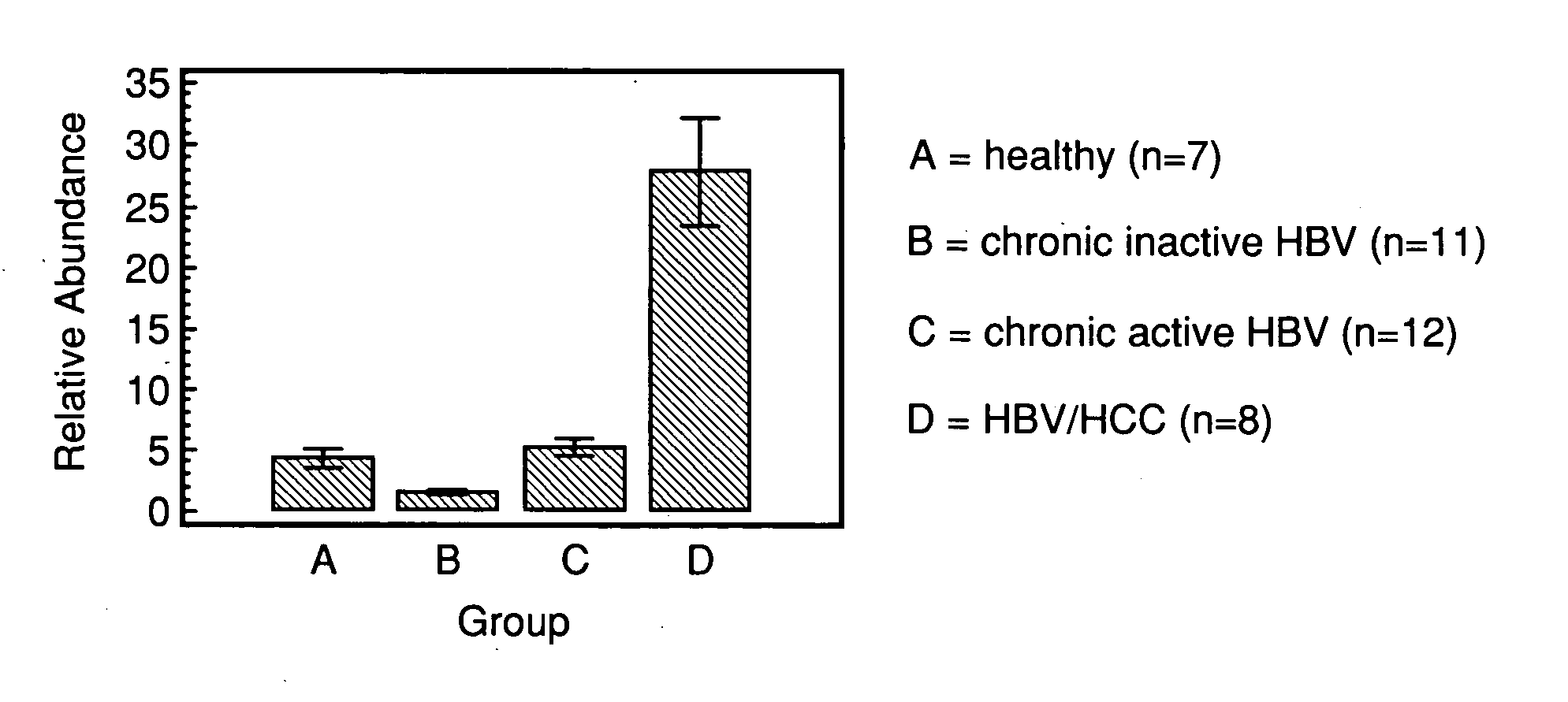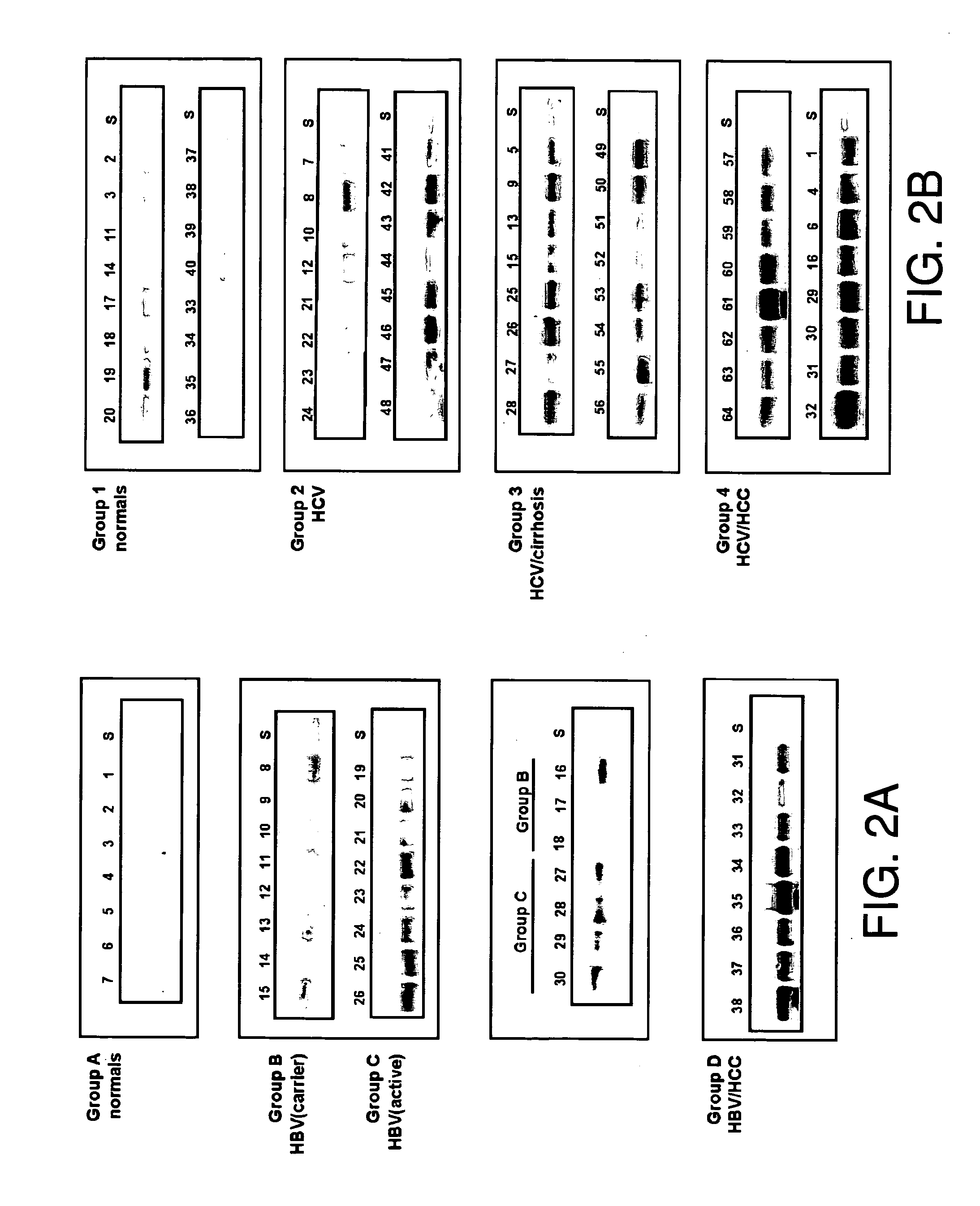Diagnosis and monitoring of hepatocellular carcinoma
a hepatocellular carcinoma and hepatocellular carcinoma technology, applied in the field of hepatocellular carcinoma diagnosis, can solve the problems of pain, inconvenient, limited value of afp as a sole indicator of hcc,
- Summary
- Abstract
- Description
- Claims
- Application Information
AI Technical Summary
Benefits of technology
Problems solved by technology
Method used
Image
Examples
example 1
Detection of GP73 in Serum of Hepatocellular Carcinoma Patients
[0069] Serum Samples and Patient History
[0070] Serum samples were collected with the informed consent of participants and in accordance with procedures approved by the Institutional Review Boards of the Fox Chase Cancer Center, Thomas Jefferson University, and the University of Michigan, where applicable. These samples were used in subsequent examples as well. Two groups of patients were included. A group of HBV-infected and control patients was comprised of 38 male subjects of Chinese ethnic background with a minimum age of 35 years, who resided in the United States at the time of sample collection. Because these patients are from a population where HBV is highly endemic, it is likely that all were infected in infancy or early childhood. HBV infection was established based on HBV surface antigen (HBsAg) positivity and on the detection of HBV-DNA in serum. HBV DNA was detected by a “dot blot” method and has a detection...
example 2
Detection of GP73 in Serum of Hepatocellular Carcinoma Patients
[0081] Methods
[0082] Serum samples were obtained, and immunoblot analyses were performed, as described above. Densitometric analyses of the immunoblots were performed to quantify the amounts of GP73 protein in patient sera, relative to the signal present in the Sigma control serum. The signal for the Sigma control serum was set to a value of 1.0.
[0083] GP73-specific signals from the 73 kDa species were quantified from X-ray film using an AlphaInnotech FluorChem CCD camera with AlphaEase spot densitometry software, and expressed as integrated intensity units relative to the GP73 signal detected in Sigma control serum (lane S on each blot). Values were calculated as the mean of duplicate or triplicate determinations for each serum sample and results.
[0084] Aliquots of human serum (0.5 μl) were obtained from the following HBV study subjects: HBV-negative (Group A); HBV carrier with inactive infection (Group B); HBV carr...
example 3
Comparison of serum GP73 and AFP in Detecting HCC
[0093] Based on the results obtained in Example 2, a larger blinded study was performed, focusing on a well-characterized HCV-infected cohort (n=142). The levels of GP73 and AFP were measured in sera from patients with HCV-associated liver disease and control patients. Patient groups and demographics are defined in Table 3.
TABLE 3Demographics of the larger cohort of patients with Hepatitis C.ChronicNormalHepatitisCirrhosisHCCVariable(n = 40)(n = 35)(n = 35)(n = 33)P valueAge 51 ± 9.754 ± 6 51 ± 851 ± 100.14Gender (M:F)30:1020:1416:928:50.32AFP (ng / ml)2.94 ± 1.6 10.8 ± 23 19.7 ± 38 11788 ± 60359% 100887755% 20-2000122324% >20000021ALT (IU / ml)28.6 ± 9 67 ± 41112 ± 12481 ± 49#AST (IU / ml)22 ± 5 53 ± 3694 ± 85109 ± 59 0.003*Bilirubin0.4 ± 0.20.5 ± 0.40.9 ± 0.61.2 ± 0.90.13(mg / dl)MELD score 5 ± 0.26.1± 0.47.8 ± 1.88.3 ± 2.10.03*TNM State %NANANA9 / 12 / 6 / 6(I / II / III / IV)
#Group 3 versus 1 and 2.
*Group 4 versus 1 and 2.
NA = not applicable...
PUM
| Property | Measurement | Unit |
|---|---|---|
| molecular weight | aaaaa | aaaaa |
| molecular weight | aaaaa | aaaaa |
| chemiluminescent assay | aaaaa | aaaaa |
Abstract
Description
Claims
Application Information
 Login to View More
Login to View More - R&D
- Intellectual Property
- Life Sciences
- Materials
- Tech Scout
- Unparalleled Data Quality
- Higher Quality Content
- 60% Fewer Hallucinations
Browse by: Latest US Patents, China's latest patents, Technical Efficacy Thesaurus, Application Domain, Technology Topic, Popular Technical Reports.
© 2025 PatSnap. All rights reserved.Legal|Privacy policy|Modern Slavery Act Transparency Statement|Sitemap|About US| Contact US: help@patsnap.com



